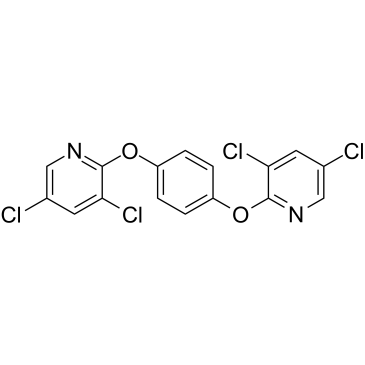1,4-双((3,5-二氯吡啶-2-基)氧基)苯

1,4-双((3,5-二氯吡啶-2-基)氧基)苯结构式

|
常用名 | 1,4-双((3,5-二氯吡啶-2-基)氧基)苯 | 英文名 | TCPOBOP |
|---|---|---|---|---|
| CAS号 | 76150-91-9 | 分子量 | 402.05900 | |
| 密度 | 1.518g/cm3 | 沸点 | 444.8ºC at 760 mmHg | |
| 分子式 | C16H8Cl4N2O2 | 熔点 | N/A | |
| MSDS | 中文版 美版 | 闪点 | 222.8ºC |
|
The commonly used antimicrobial additive triclosan is a liver tumor promoter.
Proc. Natl. Acad. Sci. U. S. A. 111(48) , 17200-5, (2014) Triclosan [5-chloro-2-(2,4-dichlorophenoxy)phenol; TCS] is a synthetic, broad-spectrum antibacterial chemical used in a wide range of consumer products including soaps, cosmetics, therapeutics, and plastics. The general population is exposed to TCS because of... |
|
|
A novel toxicogenomics-based approach to categorize (non-)genotoxic carcinogens.
Arch. Toxicol. 89 , 2413-27, (2015) Alternative methods to detect non-genotoxic carcinogens are urgently needed, as this class of carcinogens goes undetected in the current testing strategy for carcinogenicity under REACH. A complicating factor is that non-genotoxic carcinogens act through seve... |
|
|
Pyrene is a Novel Constitutive Androstane Receptor (CAR) Activator and Causes Hepatotoxicity by CAR.
Toxicol. Sci. 147 , 436-45, (2015) Polycyclic aromatic hydrocarbons (PAHs) are a class of ubiquitous persistent environmental pollutants which are primarily formed from the incomplete combustion of organic materials. Many potential sources of human exposure to PAHs exist, including daily expos... |
|
|
Dichlorodiphenyltrichloroethane technical mixture regulates cell cycle and apoptosis genes through the activation of CAR and ERα in mouse livers.
Toxicol. Appl. Pharmacol. 271(2) , 137-43, (2013) Dichlorodiphenyltrichloroethane (DDT) is a widely used organochlorine pesticide and a xenoestrogen that promotes rodent hepatomegaly and tumours. A recent study has shown significant correlation between DDT serum concentration and liver cancer incidence in hu... |
|
|
Clofibric acid induces hepatic CYP 2B1/2 via constitutive androstane receptor not via peroxisome proliferator activated receptor alpha in rat.
Biosci. Biotechnol. Biochem. 78(9) , 1550-9, (2014) Peroxisome proliferator activated receptor α (PPARα) ligands, fibrates used to control hyperlipidemia. We demonstrated CYP2B induction by clofibric acid (CFA) however, the mechanism was not clear. In this study, HepG2 cells transfected with expression plasmid... |
|
|
Coordinated regulation of nuclear receptor CAR by CCRP/DNAJC7, HSP70 and the ubiquitin-proteasome system.
PLoS ONE 9(5) , e96092, (2014) The constitutive active/androstane receptor (CAR) plays an important role as a coordinate transcription factor in the regulation of various hepatic metabolic pathways for chemicals such as drugs, glucose, fatty acids, bilirubin, and bile acids. Currently, it ... |
|
|
The cytochrome P450 2AA gene cluster in zebrafish (Danio rerio): expression of CYP2AA1 and CYP2AA2 and response to phenobarbital-type inducers.
Toxicol. Appl. Pharmacol. 272(1) , 172-9, (2013) The cytochrome P450 (CYP) 2 gene family is the largest and most diverse CYP gene family in vertebrates. In zebrafish, we have identified 10 genes in a new subfamily, CYP2AA, which does not show orthology to any human or other mammalian CYP genes. Here we repo... |
|
|
Growth arrest and DNA damage-inducible protein (GADD34) enhanced liver inflammation and tumorigenesis in a diethylnitrosamine (DEN)-treated murine model.
Cancer Immunol. Immunother. 64 , 777-89, (2015) Growth arrest and DNA damage-inducible protein (GADD34/Ppp1r15a) is induced by various stimuli including DNA damage and ER stress. DNA damage and oncogene activation, accompanied by tumor-specific DNA repair defects and a failure to stall the cell cycle, are ... |
|
|
Nonsterol Isoprenoids Activate Human Constitutive Androstane Receptor in an Isoform-Selective Manner in Primary Cultured Mouse Hepatocytes.
Drug Metab. Dispos. 44 , 595-604, (2016) Our laboratory previously reported that accumulation of nonsterol isoprenoids following treatment with the squalene synthase inhibitor, squalestatin 1 (SQ1) markedly induced cytochrome P450 (CYP)2B1 mRNA and reporter activity in primary cultured rat hepatocyt... |
|
|
Inducibility of drug-metabolizing enzymes by xenobiotics in mice with liver-specific knockout of Ctnnb1.
Drug Metab. Dispos. 37(5) , 1138-1145, (2009) Basal as well as xenobiotic-induced expression of the main enzymes from phase I and phase II of drug metabolism is confined to the perivenous areas of the mammalian liver lobule. Whereas signal transduction pathways that govern xenobiotic-induced expression o... |